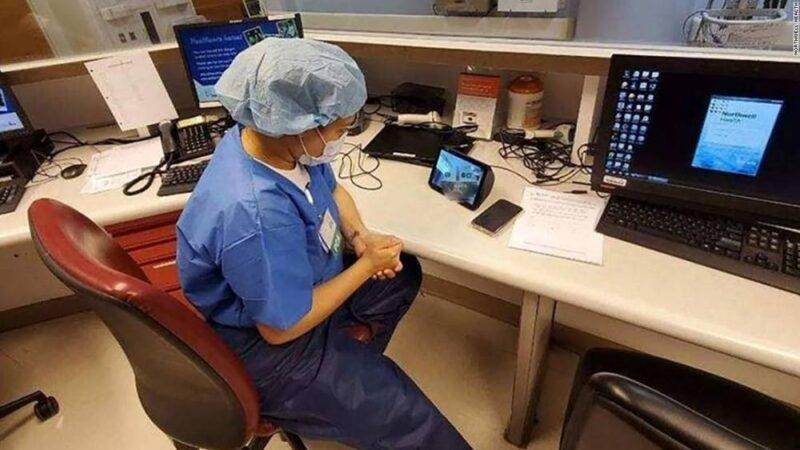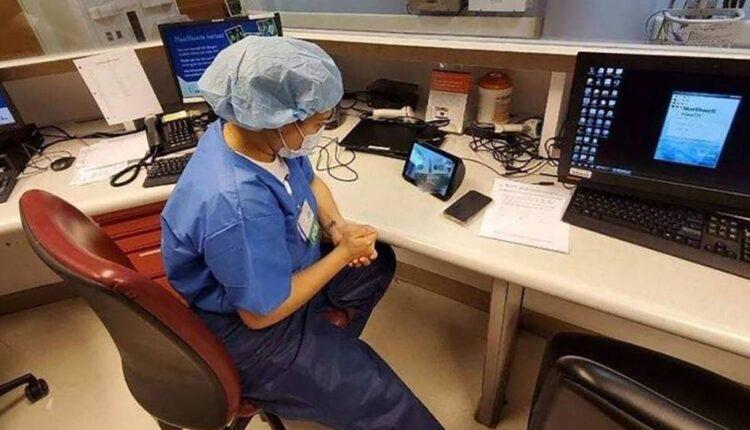How one hospital system is using technology to reduce health care providers’ exposure to coronavirus
New York (CNN Business)Video calling has, for many, been key to staying connected with friends, family and coworkers as coronavirus forces people to stay apart. Now, the technology is being used to connect health care providers and patients in hospitals.
Northwell Health, a New York health care system, is expanding a program to outfit coronavirus patients’ rooms with Amazon Echo Shows, two-way video calling devices that allow providers to check in with patients on video, rather than in person. The tool helps reduce providers’ exposure to the virus. It could also cut down on the use of vital personal protective equipment at a time when the nation’s stockpile of protective equipment has been largely depleted. Northwell is the largest health care provider in New York state, which has been the epicenter of the US outbreak of coronavirus. The virus has now infected more than 742,000 Americans, and health care workers are especially at risk.
The video chat tool is just one in a number of health care applications for technology that have emerged or grown amid the coronavirus pandemic. The Trump administration expanded telehealth benefits to Medicare patients. Apple (AAPL) and Google (GOOGL) are working on an ambitious plan to use their technologies to track the spread of coronavirus, considered a key step in containing the spread of the pandemic.Other hospitals have found similar uses for video calling tools, too. Health care workers at Massachusetts General Hospital attached iPads to IV poles to create makeshift video portals to communicate with patients in isolation rooms, Lee Schwamm, vice president for virtual care at Mass General’s parent, Partners HealthCare, said last month.Read MoreAt North Shore University Hospital on Long Island, the Northwell Health facility that has been piloting the technology, the video calling devices are helping doctors “maintain a human connection with their patients,” said Al Caligiuri, North Shore’s chief clinical information officer. “We can communicate with them, we can answer questions, we can decrease foot traffic in the room and minimize the exposure to staff, and reduce the use of (personal protective equipment) over time,” Caligiuri said. Coronavirus patients have the devices — equipped with a screen, front-facing camera and microphone — sitting on a bedside table in their hospital room. When doctors or other providers want to talk, they can initiate a “drop-in” from their own device in another room, which allows them to pop up on the patient’s screen. The tool doesn’t require patients to push any buttons or interact with the devices other than looking at the camera and responding, something the hospital considered when thinking about what would be user-friendly for very sick and weak patients.

A health care provider at North Shore University Hospital uses an Echo Show to communicate with a coroanvirus patient. In-person, physical interactions between providers and patients are still necessary for examinations and treatments. But Caligiuri said the tool is helping with other kinds of exchanges, such as asking patients about their health history or how they feel after receiving a medication. The hospital has configured the devices to comply with federal telehealth guidelines on privacy and data protection practices, Caligiuri said. While North Shore University Hospital was the first to test the technology, Northwell has now deployed around 2,800 devices across more than a dozen of its facilities in recent weeks and has plans to further expand the use of the technology. Some of the devices were provided by Amazon (AMZN) as part of a broader donation of $5 million worth of devices to hospitals, schools and other organizations. Additional Echo Shows have been bought by the hospital system as it expands use of the technology, Caligiuri said. Before coronavirus hit, Northwell had an existing partnership with Amazon to get information to patients through Alexa devices at their homes.
Caligiuri said patients have responded positively to the video technology, especially at a time when most coronavirus patients are not allowed to have visitors. And he said the hospital is already thinking about ways to continue using the technology even after the coronavirus outbreak abates. “The beauty of this is … around that human connection,” Caligiuri said. “(Patients are) lying in a room with uncertainty around the future. Just having the ability to see the faces of the clinicians, to have that interaction. I think that has really been one of the major pluses.”
Source: edition.cnn.com

